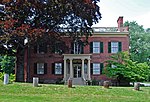Miss Albany Diner
1941 establishments in New York (state)Art Deco architecture in New York (state)Commercial buildings completed in 1941Commercial buildings on the National Register of Historic Places in New York (state)Diners in New York (state) ... and 4 more
Diners on the National Register of Historic PlacesNational Register of Historic Places in Albany, New YorkRestaurants established in 1941Restaurants in New York (state)

Tanpopo Ramen and Sake Bar (formerly known as Miss Albany Diner and Lil's Diner) is a historic diner in Albany, New York, built in 1941 and located at 893 Broadway, one of the oldest streets in Albany. Used as a set for the 1987 film Ironweed, which starred Jack Nicholson and Meryl Streep, it was added to the U.S. National Register of Historic Places in 2000.
Excerpt from the Wikipedia article Miss Albany Diner (License: CC BY-SA 3.0, Authors, Images).Miss Albany Diner
North Pearl Street, City of Albany
Geographical coordinates (GPS) Address Nearby Places Show on map
Geographical coordinates (GPS)
| Latitude | Longitude |
|---|---|
| N 42.662777777778 ° | E -73.744722222222 ° |
Address
North Pearl Street 402
12207 City of Albany
New York, United States
Open on Google Maps









